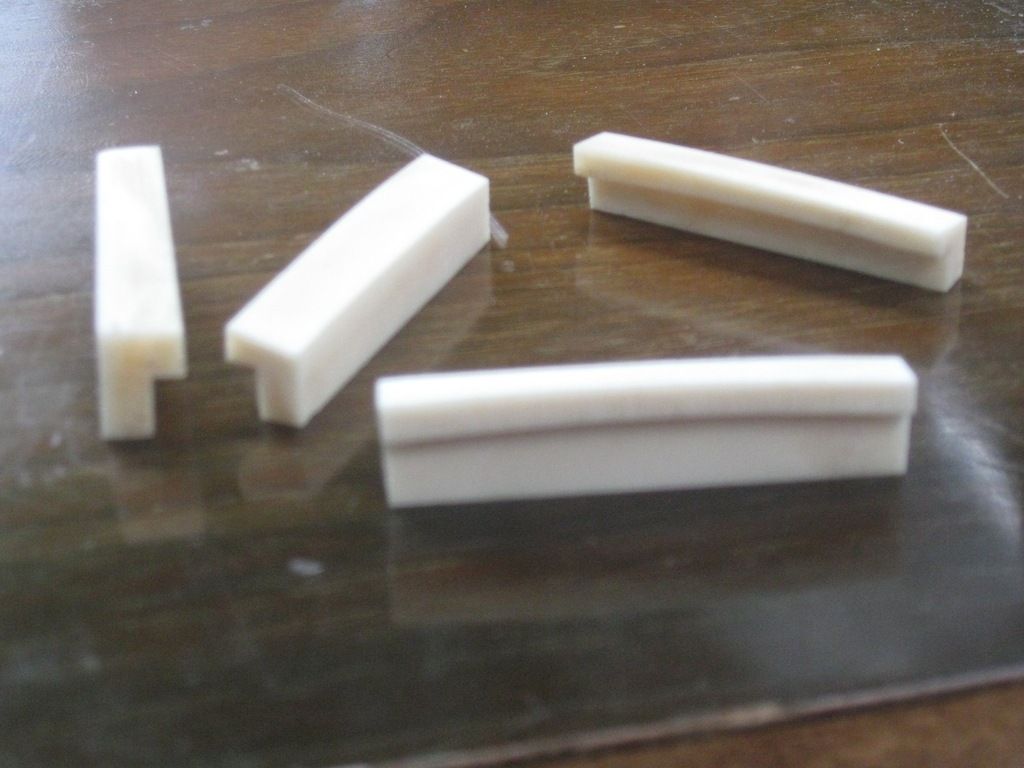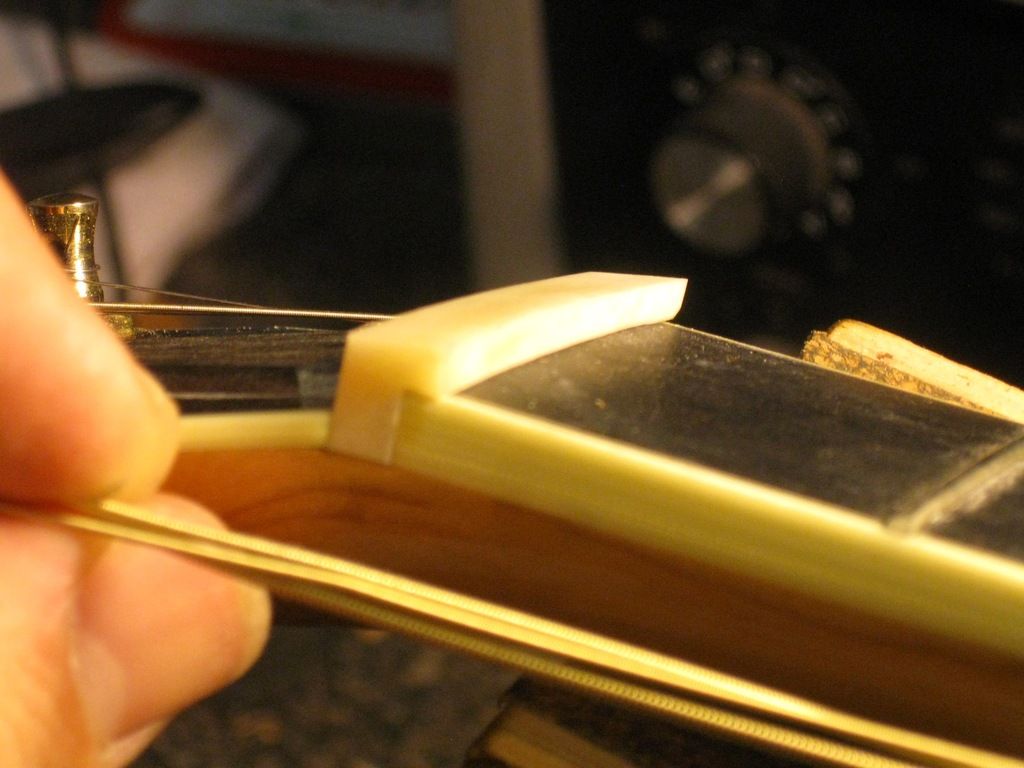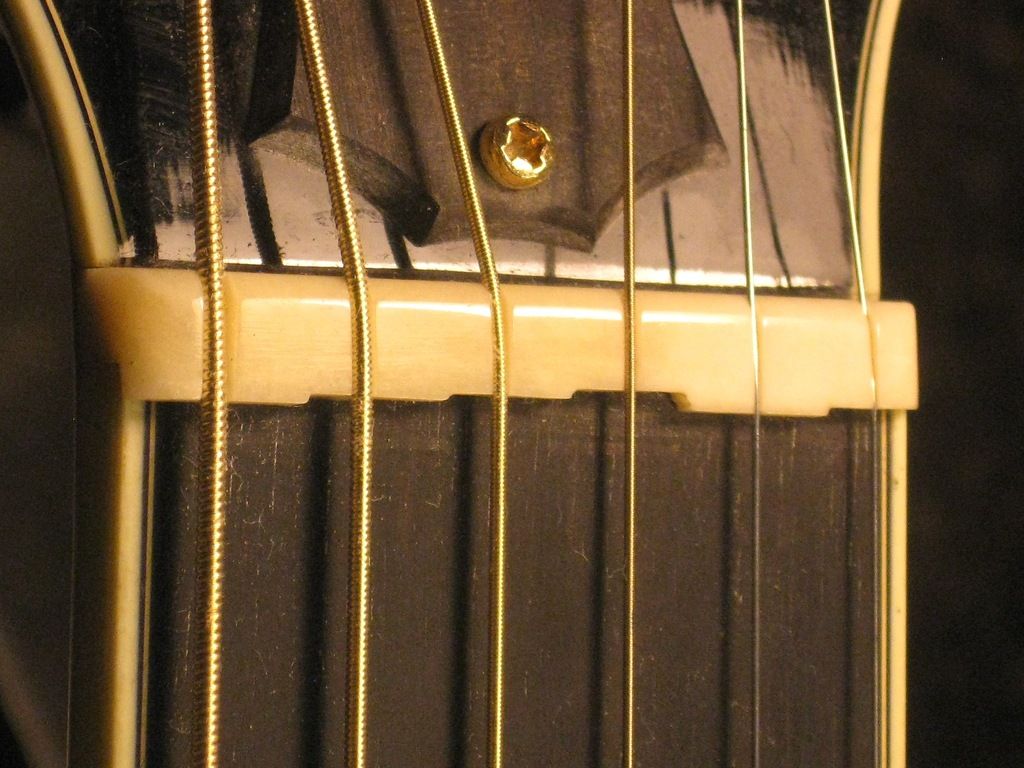
 |
|
#16
|
|||
|
|||
|
Sorry I didn't see this thread before...
I shorten the 1st fret distance by about 3/32", as the numbers in the Gore/Gilet book put the low E nut compensation at 2.23mm (.088"). But it's not a big deal if you use less than the ideal amount of nut compensation. As long as the saddle compensation is adjusted correctly to work with it, it will still be at least as good as a normal guitar. Your ramps are going the wrong way. They should match the saddle, like this:  For the saddle compensation, start with the numbers from the StewMac calculator, and adjust them according to how much nut compensation you use. Use the full .050" you have available on the low E, and subtract .050" from the StewMac saddle low E position to match. Use the full .050" on the B as well. And about .035" on the G and high E. So then subtract .035" from the StewMac high E position to match. When positioning the saddle with those modified numbers, measure relative to the 12th fret, because the nut is no longer a reliable reference point. |
|
#17
|
|||
|
|||
|
Nut compensation primarily affects the pitch of notes played on the lower frets, while saddle compensation is more effective in higher positions. You have to check the pitch at both ends to get both settings. From what you've said, and the fact that you ended up with pretty much the usual numbers at the saddle with none at the nut, it's not entirely clear that you've been doing that. My apologies if you have.
Trevor Gore spends a fair amount of time on this in his book. One recommendation he makes for a simplified setup is to take the usual bridge compensation and split it about equally between the nut and saddle. That is, if the usual shift is to move the break point of the string on the saddle back by .1", then you can move the nut forward by .05" and the saddle back by the same amount. This may not be perfect for either end of the string, but it will tend to be closer than no nut compensation at all. |
|
#18
|
|||
|
|||
|
The logical problem I've always had with overly compensated nuts is - what effect do they have past the first fret? Capo on at the first fret and the compensated nut is kind of over-ruled, no?
I put almost all of my compensation at the saddle, and I move the nut forward from the theoretical zero position by about .015". This compensates for the fact that the open string is the only note on that string that is not pressed down to a fret, stretching the string. Moving the nut compensates for that, while moving the saddle compensates for all the other frets. In my addled view, anyway.
__________________
Brian Evans Around 15 archtops, electrics, resonators, a lap steel, a uke, a mandolin, some I made, some I bought, some kinda showed up and wouldn't leave. Tatamagouche Nova Scotia. |
|
#19
|
|||
|
|||
|
Quote:
But without capo, then one way to look at it is that if you adjust the saddle compensation to make all the fretted notes as good as possible, then the open strings will be way flat. The normal compensation style is a compromise between good open strings and good fretted notes. But with nut compensation you can just shorten the open strings to fix them independently of the fretted notes. |
|
#20
|
|||
|
|||
|
Quote:
__________________
disclaimer I don't know anything, everything I say is a guess, estimate, hearsay, or opinion. For your safety, don't assume anything I say is a fact. Research |
|
#21
|
|||
|
|||
 I wasn't a fan of how a shim would look on the neck binding (stopping short of the nut) so I filed a shelf in the nut to take the length of the first fret back to spec., and just done it without nut compensation. My problem was mostly due to (my thought) the tuner I am using which is an app on my smasung galaxy tablet. Even setting the threshold and carefully controling how hard I hit the string, it gave some very wide readings, like over 10 cents, playing the same note at the same volume over and over and over. I don't have a decent microphone, so this is the only option I really had. This whole guitar was a real struggle. I don't even have a fret file. I hand dressed every fret (twice). I have no tools, but a strong desire.
__________________
disclaimer I don't know anything, everything I say is a guess, estimate, hearsay, or opinion. For your safety, don't assume anything I say is a fact. Research |
|
#22
|
|||
|
|||
|
I would never do a compensated nut to compensate for high nut slots. IMO the only good reason to make a compensated nut is to compensate for poor left hand technique. Therefore, I'm not convinced that a compensated nut would be beneficial for most players, but at my shop they have been requested by a couple of my customers, so I devised a way to mill my own radiused "shelf" blanks:
[IMG]  [/IMG] [/IMG]The customer who owns this guitar does praise and worship, and he says he just presses down too hard with his left hand in the heat of the moment, and he thought a compensated nut might help. It seemed to be the right solution for this customer (maybe the "right" solution would be for him to improve his technique, but the compensated nut made an immediate and noticeable improvement). I don't use any math equation to calculate nut compensation. I just file material away until it sounds right and looks right on the tuner when I heavy-handedly fret the open chord positions. As imprecise as it sounds, it worked out great. [IMG]  [/IMG] [/IMG][IMG]  [/IMG] [/IMG]
|
|
#23
|
|||
|
|||
|
I've always found that nut compensation helps the intonation with a capo, rather than hurting it. It's not perfect, because when you're playing with a capo on you're in effect fretting the string in two places instead of one, but it at least makes up for one of those.
|
|
#24
|
||||
|
||||
|
Quote:
|